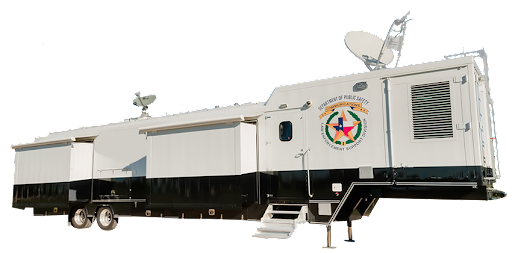
What is a mobile command center, and how can integrating one into your infrastructure change how you provide first responder services?
A mobile command center is a transport vehicle that’s been converted into a mission hub. Mobile incident command centers house the equipment, supplies and staff organizations need to respond to situations in the field.
Mobile command center benefits include:
- Faster emergency response times
- Increased access to underserved communities
- Customizable units for specific tasks
- Reliable backup if brick-and-mortar facilities go offline
Today, we’re exploring mobile command units in more detail and spotlighting why your organization might consider building one.
What is a Mobile Command Center (MCC)?
A mobile command center (MCC) is a specialty vehicle that can be moved or positioned in the field for use as a mission hub. If you’ve seen a police department trailer or EMS van at a concert or music festival, you’ve seen an MCC firsthand.
First responders and other critical organizations can convert a variety of vehicles into MCCs, including:
- Passenger vans
- Buses
- Box trucks
- Semi-trucks
- RVs
But what kinds of equipment do MCCs typically contain? The US Department of Homeland Security’s Mobile Command Vehicles feature:
- VHF, UHF, 800 and 900 Megahertz radio systems
- Cellular and satellite data connectivity
- Secure telephones
- Security imaging tools (e.g., cameras and monitors)
- Computer workstations
- Weather monitoring equipment
- A 20 kW generator
These tools support an on-site command, communications and mission control hub that you can deploy anywhere, anytime.
4 Benefits of MCCs
So how could an MCC support your organization’s critical activities in your community? Here are four advantages of integrating MCC units into your response network.
1. Swift Response
MCCs have the potential to decrease overall response times. A 2022 study of EMS response times examined 165 scenarios to determine actual mean response times compared to perceptions of response times. The study revealed that:
- Mean response times for the sample were 14.44 +/- 4.86 minutes
- Mean perceived response times were 18.28 +/- 8.10 minutes
Although response times were swift, respondents in the sample still perceived wait times as longer than they actually were.
Since units are already deployed in the field, they can reach crisis areas faster than units deployed from a brick-and-mortar command post.
2. Access to Communities Anywhere
Particularly in rural communities, a lack of a physical headquarters can create underserved geographic ranges.
Consider mobile blood donation vehicles. In rural communities far from blood centers, mobile units might provide residents’ only opportunity to donate blood without significant travel time.
The same can be said for public safety organizations without a demand for a 24/7/365 brick-and-mortar facility. Regular visits from an MCC could provide communities with the resources they need without requiring long commutes from residents and public safety organizations.
3. Customized Units for Specific Tasks
There are a variety of scenarios that stand to benefit from an MCC unit:
- Severe weather events (before, during and after)
- Specialized missions, like:
- Search and rescue
- Criminal investigations
- Surveillance operations
- Fugitive capture missions
- Large-scale infrastructure projects or demolitions
- Emergency supply distribution after a disaster
Unlike general public safety vehicles, you can customize MCCs for specific tasks. For example, a law enforcement MCC at a concert venue will likely look and operate differently than a unit supporting a criminal sting operation. This customization potential can help organizations prepare for a variety of emergency scenarios.
4. Backups for Brick and Mortar Facilities
MCCs are mobile, typically featuring independent power sources, communications systems and supply reserves. Organizations can also rely on them as a backup to brick-and-mortar facilities during natural disasters and other emergencies.
Let’s explore a sample scenario:
A category five hurricane is predicted to hit a medium-sized town with two brick-and-mortar fire stations. When the storm hits, a large tree falls on one of these facilities, and occupying the building is no longer safe.
Staff from the brick-and-mortar facility can deploy an MCC to continue providing services without relying upon their typical headquarters.
Critical Technologies for MCCs
MCCs can provide various benefits and improved service opportunities for public safety organizations. But before you start looking for a vehicle to convert, take note of the critical technologies that make MCCs tick:
- Remote power – Your MCC should still be functional even without plug-in power. Integrate gas generators, battery backups and even renewable energy harvesting tools (like solar panels) to ensure consistent access.
- Rechargeable tech tools – Storage is tight in MCCs. Consider rechargeable solutions for devices like walkie-talkies and satellite phones instead of disposable batteries.
- Connectivity – MCCs need consistent, reliable and secure access to the internet. You can meet this need by employing cellular or satellite technologies (or a combination of both).
First Responder Net: Stay Connected No Matter What
MCCs have the potential to revolutionize public safety response times, increase civilian access, provide specialized support for a variety of scenarios and serve as a backup to brick-and-mortar facilities.
But no MCC is complete without robust and reliable network access.
That’s where our First Responder Net comes in. First Responder Net provides reliable off-grid communications in even the most remote mission areas. It combines the power of GEO, MEO and LEO satellite tech and all available cellular networks to create an airtight web.
Join the First Responder Net community today to discover the power of limitless access.